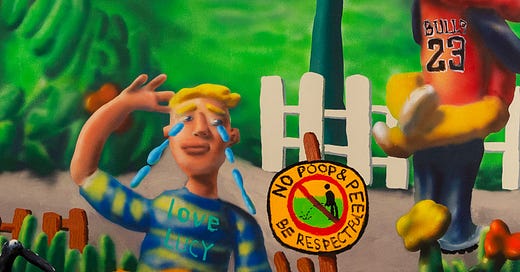Yan Jingzhou
Curated by Han Yali
29 April - 30 May 2023
Opening Reception: Saturday, 29 April at 4:00 PM
Tang Contemporary Art is honored to represent post-90s artist Yan Jingzhou as his sole agent within the Asian sector. As the artist’s first collaboration with the gallery, Yan’s solo exhibition "Buster’s Love” will open on April 29th, 2023 in Bangkok.
Yan Jingzhou graduated with a master’s degree from the Central Academy of Fine Arts. His works are dedicated to exploring modernity from a personal perspective. His characters are indifferent and humorous, who create their own discourse space through the narrative plot in the painting. In terms of visual language, his creations have the same characteristics as other post-90s artists (i.e. presenting the virtual landscape illustration through smooth media language). Unlike the usual computer-generated language, Yan Jingzhou’s works are based on “plasticine” 3D figures. Firstly, he creates an imaginative world that includes relationships among characters; then simple and short stories are born; and finally illustrated in his paintings. The main character is Buster. Art creators of his generation are widely influenced by Western postmodernism, focusing on expressing the living conditions of modern people in their creative process. Yan Jingzhou reflects the value of contemporary time and brings him closer to the culture at present.
”Buster“ is the most classic role in Yan Jingzhou’s paintings - yellow hair, big nose, big eyes, big mouth - weird, warped, and even nerdy. It is the embodiment of the artist himself. Buster represents not only an individual but also a group. The character is inspired by early puppet animations as a reference, combining both Western cartoons and Oriental fables. The artist infuses pop cultures and urban print campaigns into his artwork and adds exciting humorous content. This metaphorical viewpoint pertains the textual characteristic of dark humor, and presents an original art form, showcasing the inner elegance of the artist and a sense of boundaries drifting off reality.
In this puppet-style enchanted space, the artist touches and narrates love and fear, pain and suffering, boredom and frustration through which he investigates existential thoughts and lingering emotions of modern young people. A combination of multi-layered cultures in the picture reassembles controversial relations between humor and satire, heaviness and lightness, polyphony and counterpoint, constructing a sarcastic image language and an absurd day of Buster. The artist uses an objectified action on the surface of things from a pseudo-subjectivity perspective, combining stochastic ”gaming features” —— an unintentional simulacra and tactical simulation (from Baudrillard). As an emulating symbol, Buster resembles a pair of eyes focusing their gaze on the mundane everyday existence; it also resembles a mouth, babbling about the happenings throughout the day. Buster is an analogy of everyone in the daily grind, the modern man who keeps sinking through life’s trivia, whose frightened mindset swells with each passing moment.
With these principles in mind, the artist brings his distinctive and rich imagination into the image, deliberately confuses the imaginative and real worlds, narrates from the view of Buster, and stretches the perspective into image language. Buster, like the world he constructed, is an absurd being without any settled meaning or value. It is straightforward and penetrating as the ‘‘love’’ shown in the paintings. I Will Love You More and Not Your Love depicts a set of rivalry on the theme of love: Buster throws the baseball of love to the targeted individual with all his strength (an emitter), while the target is trembling and armed to the teeth. Cracks on the wall prove the “power” of love. The conflict of giving and receiving in love speaks for itself. Blue Shit and Red Shit are extensions of White Shit and Black Shit. The artist discusses the unpredictability of life with a pair of colors - the blue car always meets Red Shit as the white car to Black Shit, which may be random by nature. He reminds us of keeping calm when faced with these occasional accidents, just as the proverb says, ‘‘Go in one ear and out the other, like the east wind blowing in a horse’s ear.’’
Yan Jingzhou’s works start from the details of everyday life, taking the real stories and feelings of himself and the people around him as the main creation source. He incorporates people’s subjective experiences with rational thinking in the artwork and applies it in real life, depicting his true self using absurd artistic language to describe different situations in the world to the audience in a straightforward way. When we see his works, what is important is not the story he tells, but the part he doesn’t say, or the part he says, what we see is not what he narrates. In contrast, the symbols and texts he leaves in the pictures are the truth he meant to express: just like Buster, a provocative name that reflects the young generation’s bewilderment in spirit and discombobulation in behavior, allowing the audience to imagine their true conditions crudely. Behind this humorous and absurd image generates a half-visible narrative text. It is rumination and inflation, the silent laughing cries, the delay and suspension of un-happenings, and the modern dilemma of humanity.
in case you’ve missed…




